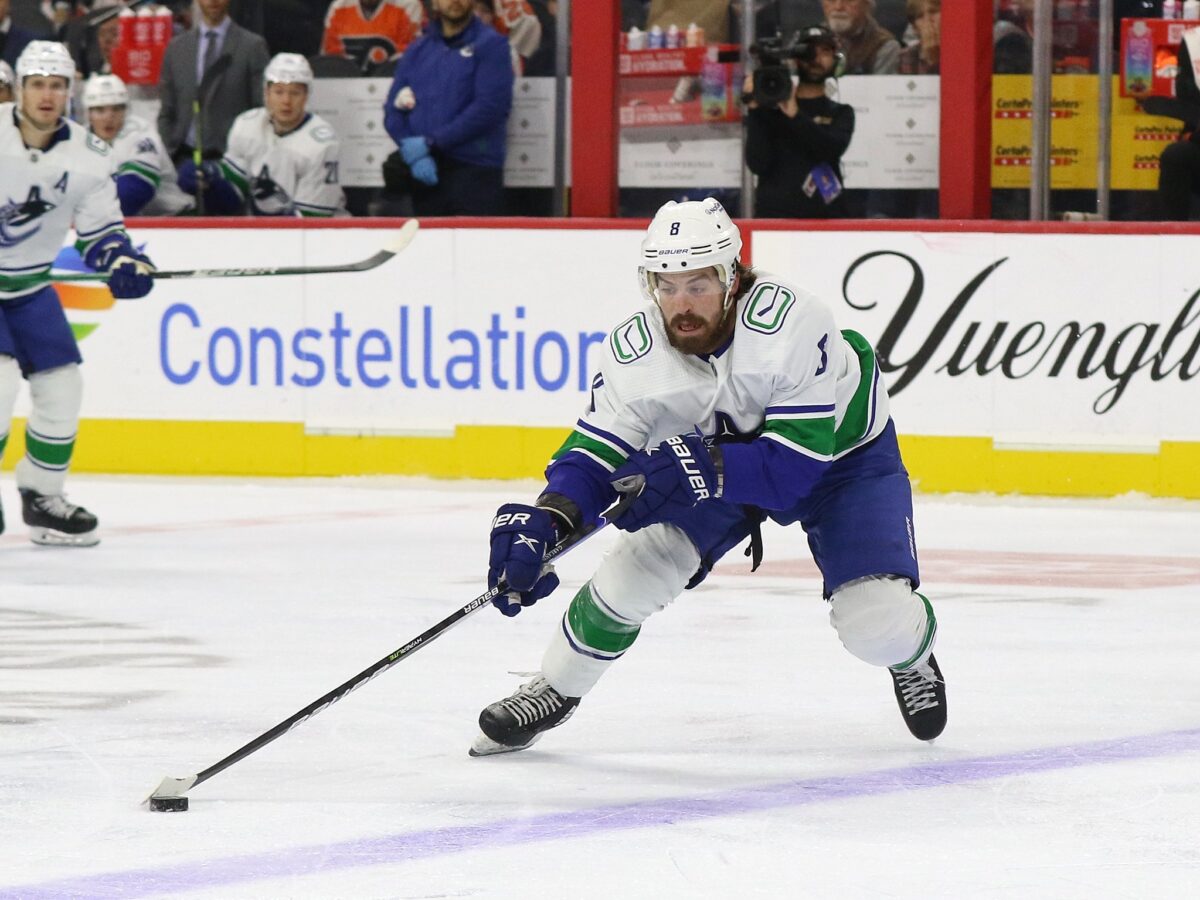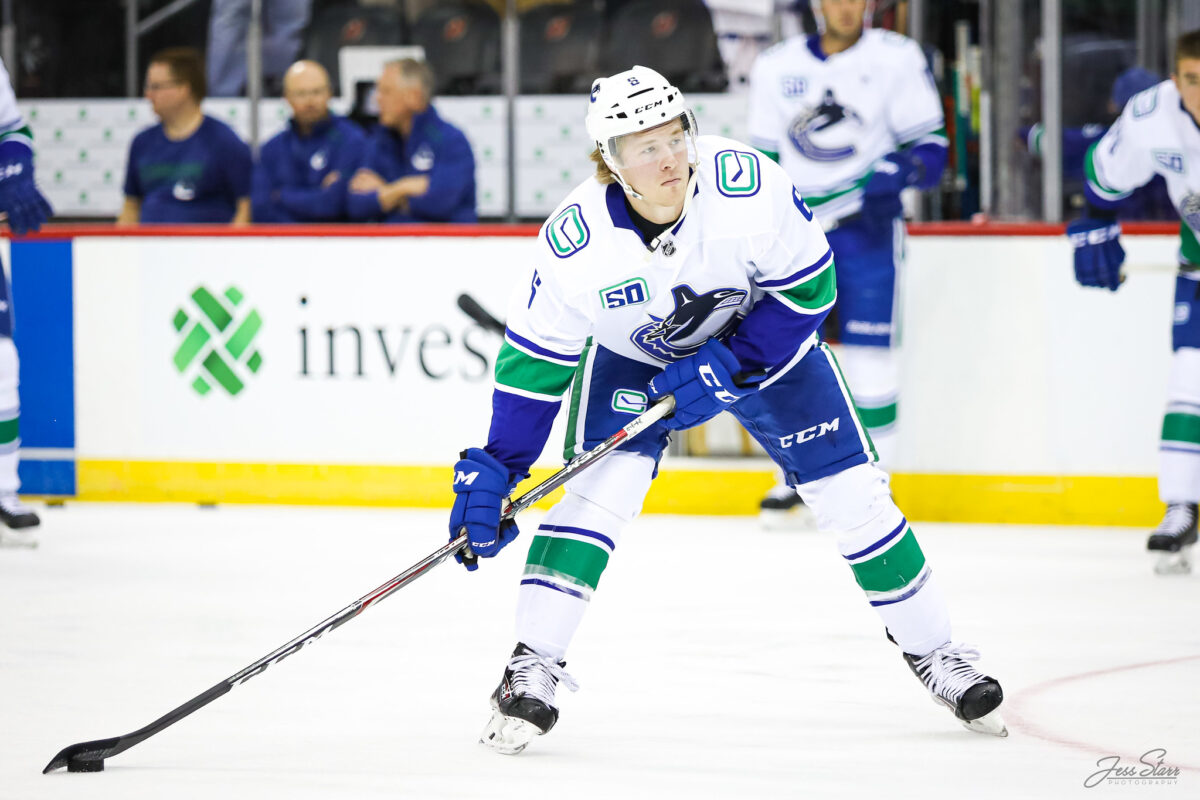The Toronto Maple Leafs and Vancouver Canucks are two teams that could make a deal as the 2023 NHL Trade Deadline approaches. Maple Leafs general manager (GM) Kyle Dubas will be actively looking for a few depth players as they prepare for a long playoff run. Meanwhile, Canucks GM Patrick Allvin is looking to sell off some of his most tradable assets in hopes of retooling the organization.
Even though there isn’t much cap room, there are a few players on the Canucks roster who may improve the Leafs’ lineup. Instead of the Leafs looking at just one player in a deal, they might also look at a package in which one or two players could move in either direction. The Bo Horvat trade has established the market, which saw a pick, a prospect, and a roster player return to Vancouver in exchange for their former captain. Because the largest name on the board has now been moved, that trade will have a domino effect on the market, so the Maple Leafs may utilize that trade as their starting point and make moves from there.
Schenn & Garland Package Adds Depth
The Maple Leafs need to add to their depth before the playoffs. Although depth players Bobby McMann and Pontus Holmberg have emerged as solid NHLers, the team still needs more up front and on the back end. Given that they are attempting to purchase assets to retool, the aforementioned Canucks would be a beneficial trading partner in this scenario. The kind of player the Leafs need on defence is Luke Schenn, who is on an expiring contract and who can fetch a respectable return. He might step in to replace the hurt Jake Muzzin, adding strength to the defensive core. Another player who should be included in the deal to give Toronto depth is Conor Garland. With 52 points scored last season and 24 so far this season, he has demonstrated that he may be a solid value for this contract.

In 2021, Garland signed a five-year deal with an average annual value (AAV) of $4.95 million, which is a lot for the Maple Leafs to take on. However, there is a chance that they might be willing to keep at least 25 percent of that if the Maple Leafs can put together a solid return. His AAV would then drop to $3.71 million, effectively replacing Alex Kerfoot’s cap hit moving forward.
Garland could be considered an upgrade over Pierre Engvall, as he has proven to score more points per season, but besides that, he can do everything else Engvall does: play on the power play and penalty kill, and be used up and down the lineup. At the end of the current season, Engvall is due for a contract extension, and if his previous negotiations are any indication, he will ask for a pay raise. Given that Garland is more productive, Toronto doesn’t need to overpay Engvall if they can bring in Garland at a reduced cap hit.
Related: 3 Potential Trade Destinations for Maple Leafs’ Alex Kerfoot
Schenn’s contract only costs $850,000 for the remainder of the season, making it a reasonable cap hit for any NHL team. The Maple Leafs lost a piece of their defense that they were unable to replace when Ilya Lyubushkin signed with the Buffalo Sabres in free agency last season, and Muzzin also suffered a potentially career-ending injury early this season. Schenn would replace it. He has 237 hits on the season and an average of 17:09 of ice time per game, and he can alter their perspective regarding the penalty kill. He also adds a lot of playoff experience. With the Tampa Bay Lightning, he won back-to-back Cups, and because he knows what it takes to win, he can provide stability to the rest of the defensive core during the postseason.
Boeser Improves the Top-Six
Brock Boeser should be traded if the Canucks are serious about retooling. He was a player who was heavily linked to trade rumors last year, and he may be linked to them once more this year. He signed an extension in the offseason as opposed to the Canucks taking a chance on the qualifying offer, which is the main difference between this season and the last. His three-year deal carries a $6.65 million AAV. The 25-year-old has a cap hit that the Maple Leafs might be able to manage. To make it work, the Maple Leafs will need to find a balance between the money coming in and the money going out.

Additionally, they must fulfill Vancouver’s request for Boeser. Toronto would be wise to include Rasmus Sandin as a player going the other way and use his spot on the backend to add more grit, much like Lyubushkin did for the team last season.
Related: Maple Leafs Can Add Depth Via Blues’ Acciari & Barbashev
Boeser has the skill set and the scoring ability to round out the Maple Leafs’ forward group, potentially making the team’s top six the best in the NHL. He scored between 45 and 56 points per season throughout his career, with 56 being a career-best in 2018-19. He currently has 30 points in 41 games and will finish the season with about 45 points. Over the next three seasons, Boeser would be able to revive his career in the Leafs’ top-six, benefiting both the team and the player.
As was already mentioned, the asking price for Boeser would probably be comparable to the Horvat deal. If so, the Maple Leafs would have to give up a B-level prospect like Fraser Minten, Roni Hirvonen, or Topi Niemelä, as well as a roster player such as Kerfoot, Engvall, or Sandin. Finally, a draft pick. Since Toronto will likely finish high in the standings, the first-rounder will be between the 22nd and 32nd picks.
Overall, as the 2023 Trade Deadline draws near, Toronto and Vancouver may prove to be successful trading partners. These two teams make sense to make a deal, whether it’s for Schenn, Garland, Boeser, or someone else on the Canucks like Dakota Joshua. It is expected that Dubas will be busy working the phones to improve the Leafs ahead of the deadline and it wouldn’t be surprising if he and Allvin have regular conversations before then.
